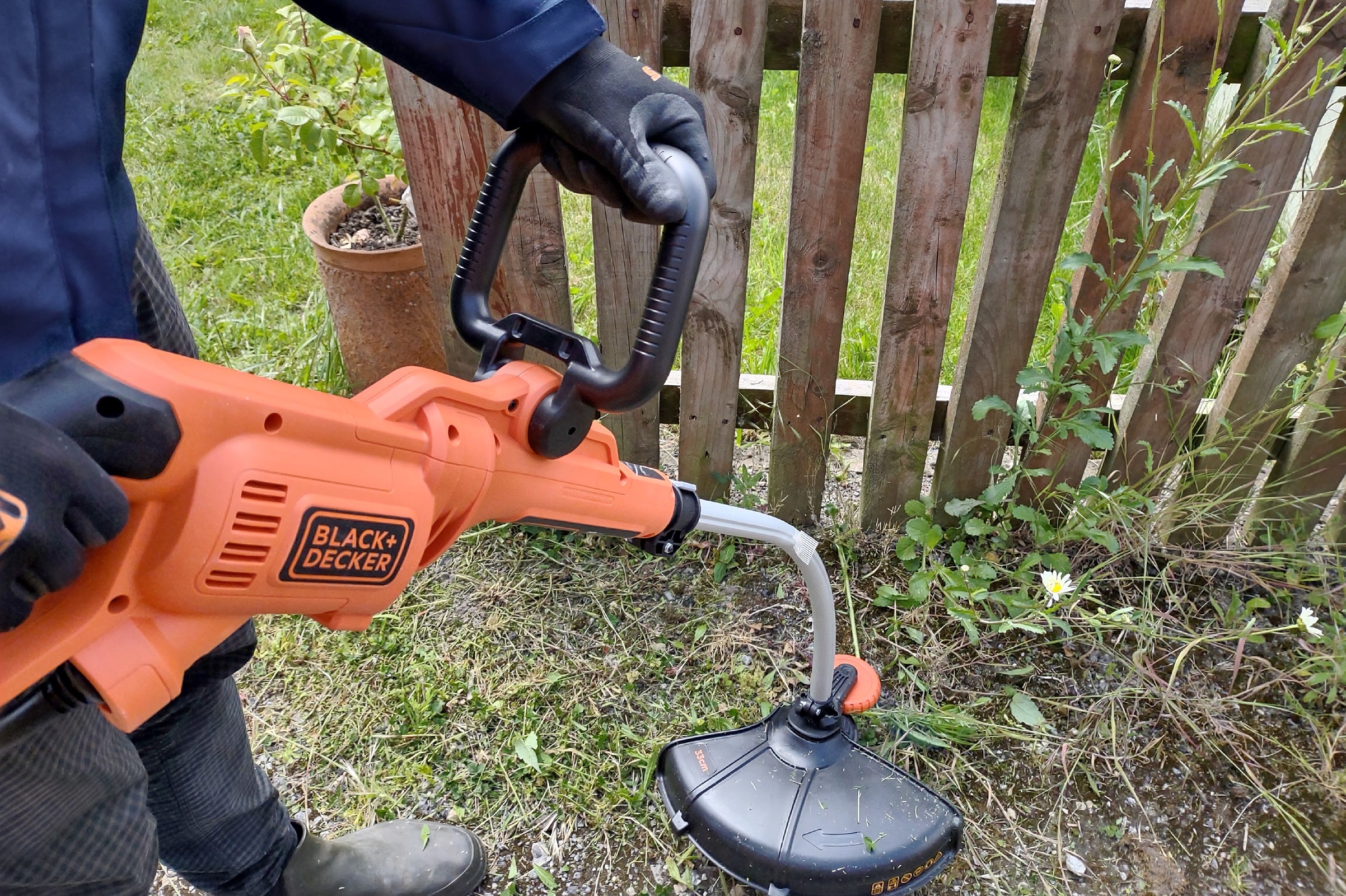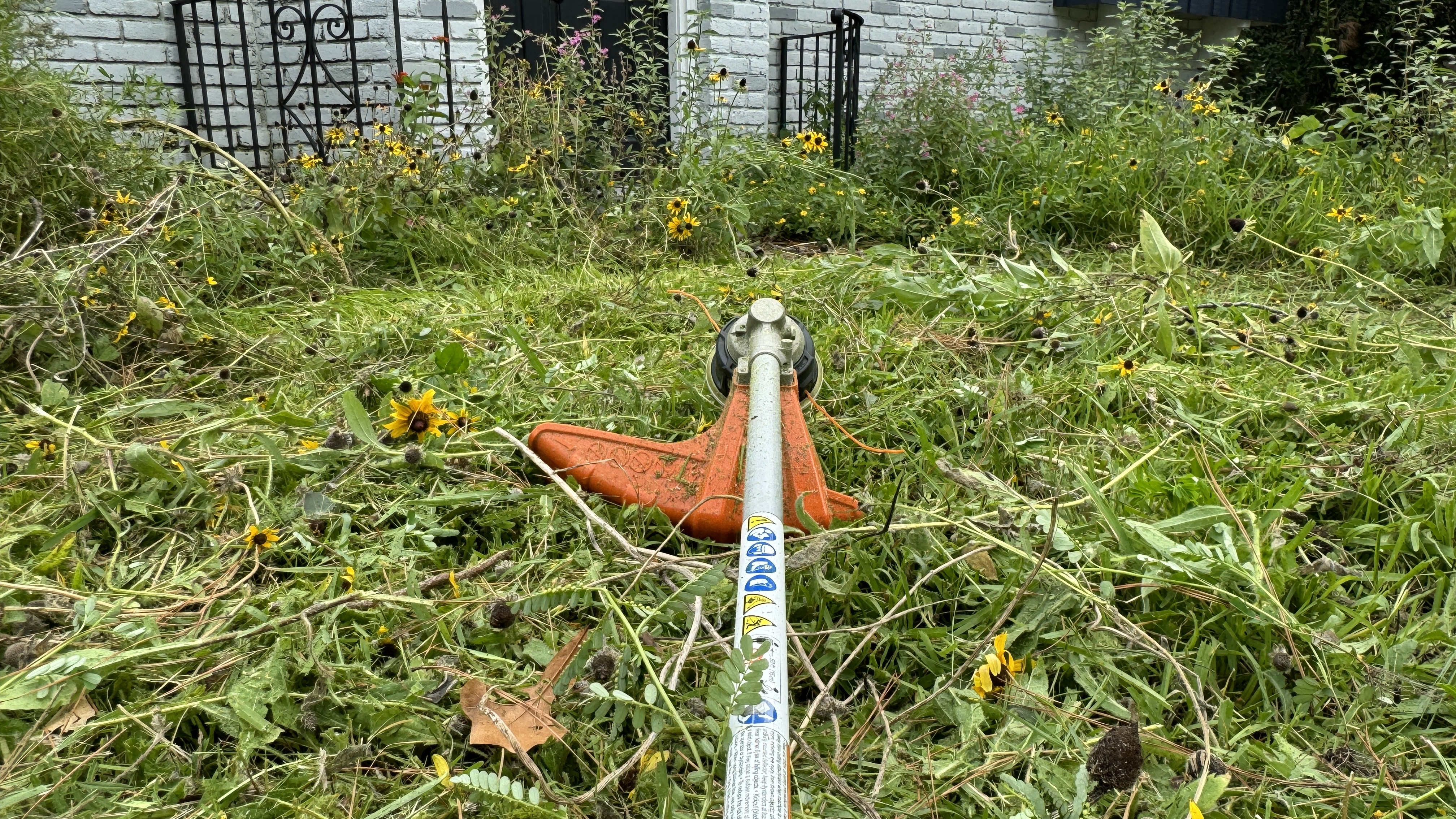A string trimmer is more than a tool for cutting down weeds – although they do weed whacking exceptionally well, from areas around trees and fences to the gaps between paving stones. The best string trimmers can do even more, with the ability to mow grass, edge lawns, and even shred leaves to make a mulch.
In this guide, I’ll break down some of the many uses of your string trimmer, from its core functions to some outside-of-the-box suggestions.
Learning the full range of uses for your string trimmer will help you get the very best out of this high-powered yard tool. You might save some money too, as you won’t need to buy additional yard tools for tasks you didn’t know your string trimmer could do.
So, without further ado, here are ten yard care jobs you can carry out with a string trimmer.

Nick Ee is a Product and Training Manager at BLACK+DECKER, a leading manufacturer of string trimmers and other tools for home and yard.
1. Trim around lawn borders
Long grass and weeds can prosper around the border of a lawn, where lawn mowers can’t reach.
A string trimmer is the perfect tool to horizontally cut this unwanted growth, after you’ve finished a mowing with your best lawn mower.
Expert tip: For a more efficient cut, mow the rest of the lawn before you trim the border.

2. Edge the lawn
With the right technique, you can use a string trimmer to edge your lawn, creating a neat border where the grass meets surrounding surfaces.
To edge a lawn, you cut vertically to remove overhanging grass around the lawn border. This forms a clean edge or trough around the perimeter. You’ll need to use a string trimmer with an invertible head to perform this action.
In the age-old string trimmer vs lawn edger debate, lawn edgers are usually the superior tool for edging a lawn, offering greater precision and a neater result. However, the greater versatility of string trimmers gives them the edge overall.
Expert guidance: Read our article on how to edge with a string trimmer.
3. Clear weeds around other plants
Weeds will often grow in the rich soil around your prized plants and trees. Unfortunately, it’s often difficult to reach these interlopers with your lawn mower – not unless you’re willing to risk damaging your plants in the process.
A string trimmer is a safer option to cut down weeds in these problem areas, as their smaller cutting area and handheld operation allow for more accurate trimming.
“Weeds can grow around the base of trees, shrubs and plants where a lawnmower can’t reach, so using a trimmer for weed control can be very effective,” says BLACK+DECKER Product and Training Manager, Nick Ee.
Expert tip: After trimming the tops off weeds that are growing in soil, dig the roots out by hand to prevent regrowth.

4. Work around fences
One of the great benefits to a string trimmer is that these tools are superb at working in tight spaces, thanks to the compact, accurate design of their trimming heads.
If you have weeds or tall grass springing up around fencing, a string trimmer is one of the best tools you could use to mow them down.
Expert tip: Use the guard on the head of a trimmer such as the BLACK+DECKER LSTE525 to avoid contact between the fence and the trimming line.
5. Remove weeds between paving
A string trimmer can be used to horizontally trim weeds growing out of cracks between paving. To do this, activate the trimmer and carefully move it back and forth across the weed-infested area. It won’t necessarily kill the weeds, but it will limit their growth and improve the appearance of the paving.
With that said, not every expert recommends using a weed whacker for this specific purpose.
“Many people use string trimmers to remove weeds from cracks in pavements or driveways, but I would avoid contact with hard surfaces like concrete, brick, metal or wood,” says Nick.
“It can cause damage to the trimmer head, wear out the string quickly, and potentially send debris flying.”
Expert tip: String trimming over a hard surface can wear the line out quickly, so keep a compatible replacement spool (like this one ($13.79, Amazon) ready.

6. Use as a lawn mower
Using a string trimmer as a mower, as you can easily with the BLACK+DECKER Combination String Trimmer, Lawn Mower and Edger for $157.99 on Amazon, is a great option for people who have a very small lawn, or who don’t have enough storage space to keep a mower at home.
Before lawn mowers were invented, wealthy landowners often had their lawns mown by scythe (or trampled!) String trimmers are not so different from scythes – and they are obviously a far more convenient alternative for mowing the lawn.
It takes skill to mow a lawn using a string trimmer, but with some practice you’ll likely gain the ability to cut the grass more evenly.
Expert tip: Trim the whole lawn in the same direction to achieve a more uniform appearance. (Grass bends slightly when you cut it, which affects how it reflects light.)

Mark has extensive experience working across several leading tool brands. As a Product Manager with string trimmer maker ECHO Incorporated – which also manufactures lawn mowers and other power tools – Mark has a deep knowledge of trimmers and how people use these tools in their yards.

7. Trim thick weeds or brush
String trimmer line is usually designed to cut relatively thin, tender weeds – not weeds that are thick or tough.
However, some weed whackers are compatible with heavier types of cutting line, sometimes referred to as ‘heavy duty line’ (HDL), capable of cutting thick weeds and brush.
In these cases, the right string trimmer might enable you to deal with dense overgrowth in your yard, without the need to buy an additional brushcutter like the ECHO eFORCE 56V X Series 17 in for $649.99 at Home Depot.
With an even tougher attachment, you can make a string trimmer even better suited to cutting dense weeds.
“Most string trimmers can be converted to use with a blade making heavier than normal clearing easier,” adds ECHO’s Mark Taylor.
Expert tips: After you’re done cutting tougher weeds, remember to remove the heavy-duty cutting line or blade attachment and replace it with your string trimmer’s regular cutting line.
8. Pre-mow the lawn, ready for your mower
Mowing very long grass can put a lot of stress on lawn mower components such as the motor or engine. So, it’s often a good idea to cut long lawn grass shorter using your string trimmer, before you mow.
As Nick puts it: “Tall grass can be tricky to cut with a lawn mower, so trimming it down to a shorter length with a trimmer first is essential.
Expert tip: Don’t worry about cutting to an even height when you pre-cut the lawn with a string trimmer; your lawn mower will level the grass out afterwards.

9. Mulch leaves
Fallen leaves can make a great ‘mulch’ – meaning they act as a sort of compost that insulates plants such as grass and gradually adds nutrients to the soil.,
To get those benefits into the soil, it helps to break down the leaves using a tool such as a lead shredder.
Perhaps surprisingly, a string trimmer can also be used for this purpose. You’ll need to gather the leaves into a pile with steep sides, then shred them with the string trimmer, starting from the center and working outwards.
Expert tip: Check your pile of leaves and remove any tree branches (or critters!) before you start mulching.
10. Use attachments for more functions
Depending on your model of string trimmer, you might be able to purchase additional attachments to fix onto the trimmer head. This opens up even more yard care possibilities.
“‘Attachment capable’ trimmers can have the lower end converted to perform many other tasks such as hedging, tilling, and pruning to name a few,” says Mark.
Expert tip: For maximum versatility, choose a string trimmer that can be fitted with various interchangeable attachments.
Your string trimmer is more than just a weed-whacking workhorse; think of it as a versatile yard care multi-tool, with a huge array of uses that also includes mowing, lawn edging, and brush-cutting (with the right heavy-duty attachment fitted).
However, string trimmers are more dangerous than most other yard tools, due to the power of the cutting line itself, and the risk of airborne debris that can get kicked up by the revolving line. They should be treated with respect.
“You should never use one of these tools without safety gear – always wear safety goggles or glasses to protect your eyes from flying debris and protective clothing to protect skin from potential injuries,” says Nick.

